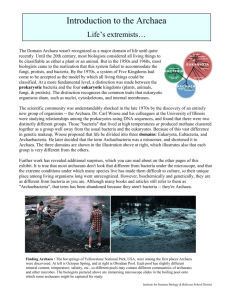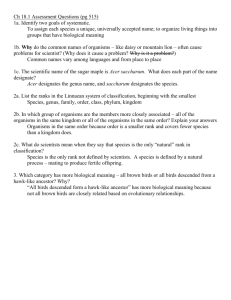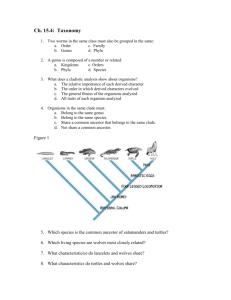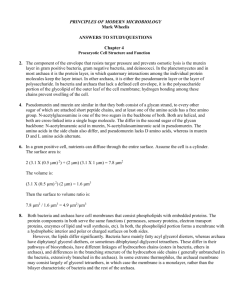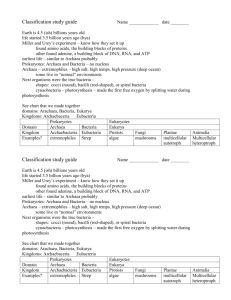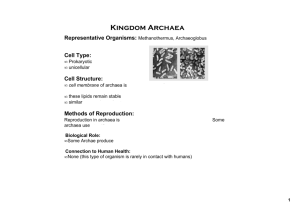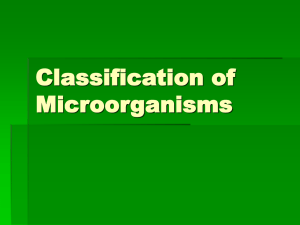Archaea Webquest and Research
advertisement
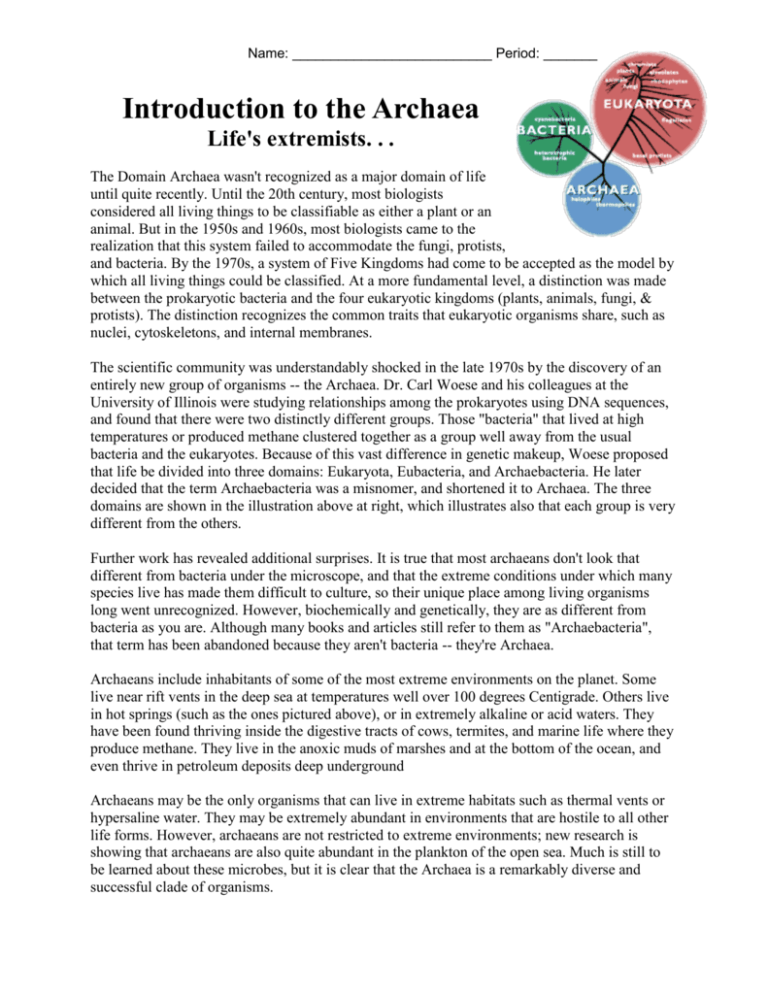
Name: __________________________ Period: _______ Introduction to the Archaea Life's extremists. . . The Domain Archaea wasn't recognized as a major domain of life until quite recently. Until the 20th century, most biologists considered all living things to be classifiable as either a plant or an animal. But in the 1950s and 1960s, most biologists came to the realization that this system failed to accommodate the fungi, protists, and bacteria. By the 1970s, a system of Five Kingdoms had come to be accepted as the model by which all living things could be classified. At a more fundamental level, a distinction was made between the prokaryotic bacteria and the four eukaryotic kingdoms (plants, animals, fungi, & protists). The distinction recognizes the common traits that eukaryotic organisms share, such as nuclei, cytoskeletons, and internal membranes. The scientific community was understandably shocked in the late 1970s by the discovery of an entirely new group of organisms -- the Archaea. Dr. Carl Woese and his colleagues at the University of Illinois were studying relationships among the prokaryotes using DNA sequences, and found that there were two distinctly different groups. Those "bacteria" that lived at high temperatures or produced methane clustered together as a group well away from the usual bacteria and the eukaryotes. Because of this vast difference in genetic makeup, Woese proposed that life be divided into three domains: Eukaryota, Eubacteria, and Archaebacteria. He later decided that the term Archaebacteria was a misnomer, and shortened it to Archaea. The three domains are shown in the illustration above at right, which illustrates also that each group is very different from the others. Further work has revealed additional surprises. It is true that most archaeans don't look that different from bacteria under the microscope, and that the extreme conditions under which many species live has made them difficult to culture, so their unique place among living organisms long went unrecognized. However, biochemically and genetically, they are as different from bacteria as you are. Although many books and articles still refer to them as "Archaebacteria", that term has been abandoned because they aren't bacteria -- they're Archaea. Archaeans include inhabitants of some of the most extreme environments on the planet. Some live near rift vents in the deep sea at temperatures well over 100 degrees Centigrade. Others live in hot springs (such as the ones pictured above), or in extremely alkaline or acid waters. They have been found thriving inside the digestive tracts of cows, termites, and marine life where they produce methane. They live in the anoxic muds of marshes and at the bottom of the ocean, and even thrive in petroleum deposits deep underground Archaeans may be the only organisms that can live in extreme habitats such as thermal vents or hypersaline water. They may be extremely abundant in environments that are hostile to all other life forms. However, archaeans are not restricted to extreme environments; new research is showing that archaeans are also quite abundant in the plankton of the open sea. Much is still to be learned about these microbes, but it is clear that the Archaea is a remarkably diverse and successful clade of organisms. Name: __________________________ Period: _______ Research the following about the domain archaea. 1. How long ago do scientists think Archaea split off and developed separately from bacteria? 2. What evidence supports the idea that eukaryotes evolved from Archaea? 3. What traits do Archaea have that suggest they may be closely related to the first life forms on earth? 4. What are the oldest cell fossils? Where have these been found? 5. How are the conditions in which Archaea live similar to what scientists believe ancient earth might have been like? 6. What are extremophiles? 7. Describe the characteristics of the following extremophiles and where they would be found. Thermophile Psychrophile Halophile Methanogen 8. A type of Archaea known as strain 121 was found in a vent on the floor of the Pacific Ocean at a depth of 1.5 miles. Strain 121 is a hyperthermophile. How has Strain 121 redefined the boundaries of life? 9. How did the discovery of life around deep sea vents change scientists' views of life on the ocean floor? 10. What is a sulfur bacteria? Where could you find these? 11. What unusual bacteria can be found at Yellowstone Park in Wyoming? (Hint : Light) 12. Find information about Thermotoga – What are its characteristics? 13. Archaea found living in Lidy Hot Springs in Idaho have given scientists hope that life may exist on other planets or moons. What is unique about Lidy Hot Springs that made scientists choose this site to study? What types of microbial community did scientists find there? 14. How are the conditions in Lidy Hot Springs similar to conditions on Mars? 15. On shows like CSI and Bones scientists are always finding the criminal by finding and matching DNA. Explain how that could never happen without our friends the Archaea.
